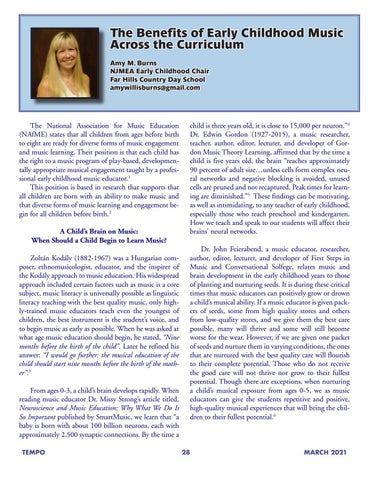The Benefits of Early Childhood Music Across the Curriculum Amy M. Burns NJMEA Early Childhood Chair Far Hills Country Day School amywillisburns@gmail.com
The National Association for Music Education (NAfME) states that all children from ages before birth to eight are ready for diverse forms of music engagement and music learning. Their position is that each child has the right to a music program of play-based, developmentally appropriate musical engagement taught by a professional early childhood music educator.1 This position is based in research that supports that all children are born with an ability to make music and that diverse forms of music learning and engagement begin for all children before birth.2 A Child’s Brain on Music: When Should a Child Begin to Learn Music? Zoltán Kodály (1882-1967) was a Hungarian composer, ethnomusicologist, educator, and the inspirer of the Kodály approach to music education. His widespread approach included certain factors such as music is a core subject, music literacy is universally possible as linguistic literacy teaching with the best quality music, only highly-trained music educators teach even the youngest of children, the best instrument is the student’s voice, and to begin music as early as possible. When he was asked at what age music education should begin, he stated, “Nine months before the birth of the child”. Later he refined his answer: “I would go further: the musical education of the child should start nine months before the birth of the mother”.3 From ages 0-3, a child’s brain develops rapidly. When reading music educator Dr. Missy Strong’s article titled, Neuroscience and Music Education: Why What We Do Is So Important published by SmartMusic, we learn that “a baby is born with about 100 billion neurons, each with approximately 2,500 synaptic connections. By the time a TEMPO
child is three years old, it is close to 15,000 per neuron.”4 Dr. Edwin Gordon (1927-2015), a music researcher, teacher, author, editor, lecturer, and developer of Gordon Music Theory Learning, affirmed that by the time a child is five years old, the brain “reaches approximately 90 percent of adult size…unless cells form complex neural networks and negative blocking is avoided, unused cells are pruned and not recaptured. Peak times for learning are diminished.”5 These findings can be motivating, as well as intimidating, to any teacher of early childhood, especially those who teach preschool and kindergarten. How we teach and speak to our students will affect their brains’ neural networks. Dr. John Feierabend, a music educator, researcher, author, editor, lecturer, and developer of First Steps in Music and Conversational Solfege, relates music and brain development in the early childhood years to those of planting and nurturing seeds. It is during these critical times that music educators can positively grow or drown a child’s musical ability. If a music educator is given packets of seeds, some from high quality stores and others from low-quality stores, and we give them the best care possible, many will thrive and some will still become worse for the wear. However, if we are given one packet of seeds and nurture them in varying conditions, the ones that are nurtured with the best quality care will flourish to their complete potential. Those who do not receive the good care will not thrive nor grow to their fullest potential. Though there are exceptions, when nurturing a child’s musical exposure from ages 0-5, we as music educators can give the students repetitive and positive, high-quality musical experiences that will bring the children to their fullest potential.6
28
MARCH 2021
